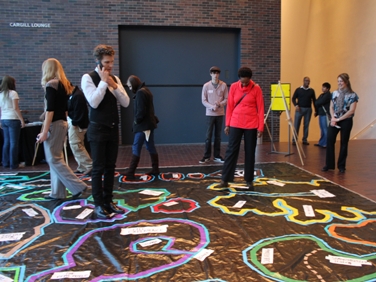Tag: Education/Engagement
WXXI and Rochester Museum promote dialogue on race
WXXI in Rochester, N.Y., is teaming up with a local museum to encourage a community dialogue on race relations. The Rochester Museum & ...WBEZ’s Curious City brings its inquisitive audience into the reporting action
From exploring underground tunnels to tracking the evolution of the Chicago accent, Curious City is an unconventional spin on community-based public media ...With young actors, Localore’s interactive Ed Zed Omega critiques education system
CPB’s American Graduate initiative has set its sights on targeting dropouts, but another project in public media, Ed Zed Omega, is zeroing ...KQED, science academy team up for e-learning project
With Earthquake, an e-book and companion iTunes U course, KQED and the California Academy of Sciences shook up a new approach to multimedia ...ITVS prepares for beta tests of enhanced OVEE
An infusion of CPB funding is allowing the Independent Television Service to add more features to OVEE, the online engagement tool that ...Utah educator named director of state’s broadband network for schools
Utah Education Network, the only public TV licensee to receive a federal broadband grant and to join the national US Ignite project ...Pubcasting tackles dropout crisis
The massive American Graduate project is all about potential — the potential of students who stay in school to graduate, as well ...US Ignite partnership will push for apps using a faster, smarter Internet
The state-operated Utah Education Network and several municipalities are among about 100 members of US Ignite, a new partnership creating services for ...In social media metrics, ROI is more than a sum of fans
... Building and maintaining a meaningful social media presence requires a significant investment of time — and it’s not always easy to ...@acarvin’s example
After the Arab Spring began, NPR's Andy Carvin remains a rare breed. More journalists are using Twitter to find stories and connect ...Face-to-face: a place for trying new things, delighting new audiences
At a time when many radio programmers are experimenting with Internet-based media, it may seem unusual for a station to take on ...Not In Our Town: ‘Public media at its best’ seeks civility
A movement against hate crimes called Not In Our Town, spawned by a 1995 documentary on PBS, has come to represent many ...Listen closely: What matters to your community — and to donors?
“Outreach is about changing somebody else. Engagement is when you have been changed,” says Mikel Ellcessor, g.m. of WDET in Detroit. “And ...New mindset requires new habits: listen, earn trust, partner-up
The professionals who work to engage public media groups in their communities are still learning what it takes. In a series of articles, ...High stakes + direct access = full engagement
Noel Gunther remembers the moment when he realized that public broadcasting had to get involved in traumatic brain injury education. It was ...









